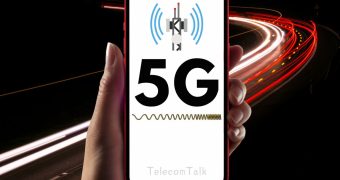
India has witnessed one of the fastest 5G rollouts globally. However, Indian operators are yet to meaningfully monetise their 5G network investments. According to Jio's Q4FY25 webinar, the company has not yet begun monetising its 5G services. We believe the situation is similar for Bharti Airtel. Earlier reports indicated that Reliance Jio plans to monetise its 5G investment through its Fixed Wireless Access (FWA) services, as they offer higher ARPU (Average Revenue Per User). Regular readers of TelecomTalk would already be familiar with this evolving scenario.
Also Read: Given Inflation, Prices Need to Catch Up: Vodafone Idea
With that context, let's explore the broader 5G FWA landscape, drawing insights from telecom operators, ISPs, and network gear vendors.
What is 5G FWA?
For those unfamiliar, here's a quick refresher:
Fixed Wireless Access (FWA) is a high-speed wireless broadband service delivered over 5G networks using Customer Premises Equipment (CPE). This setup may include an external antenna, depending on the model provided to the customer. Users experience 5G speeds through Wi-Fi connected to the CPE. However, the actual experience may vary based on the network and signal quality. We won't delve into the spectrum-related aspects of FWA here, as that's beyond the scope of this discussion.
AirFiber Solution
At the launch of 5G FWA services in India, operators introduced "AirFiber" as a solution to deliver high-speed wireless internet to "fiber-dark" areas—places where laying fiber for last-mile connectivity is not feasible due to cost, practicality, or local approval issues.
Now that the context of FWA is set, let's look at what the industry — Telcos, Broadband Provider (ISP), and Network Gear Vendor — said about FWA, with a touch of TelecomTalk's perspective.
Also Read: Govt Looking to Address Return on 5G Investments; People Consuming Data for Entertainment: Report
Industry Perspectives on 5G FWA
Telco: Bharti Airtel
Bharti Airtel was the first to launch FWA services in India over its 5G network. However, during the Q4FY23 earnings call, CEO Gopal Vittal emphasised the superior consistency and reliability of fiber connections, delivering a dedicated broadband experience to homes.
He cited a real-world example from the United States, explaining that while FWA can offer a satisfactory experience when networks are uncongested, it faces significant challenges over time. Vittal highlighted that FWA is used to initially serve areas lacking fiber, with the ultimate goal of transitioning to fiber connections for a sustainable network experience.
Coming to monetisation, according to a report citing a senior Airtel executive, operators don't deploy 5G for FWA as the economics don't work. Telcos primarily use it for mobile services and add FWA as an additional revenue source. Moreover, since it's the same network infrastructure, telcos are offering 5G FWA using Customer Premises Equipment (CPE). The executive also stated that 5G has not yet created new revenue streams for any telecom operator worldwide—5G is largely just about speed and some FWA use cases.
Airtel offers fiber-based connections wherever possible for the best experience and AirFiber (5G FWA) as the next option in case fiber is not available. According to TRAI's telecom subscription report as of February 2025, Airtel reported 1.03 million FWA users and a 10.07 million wireline subscriber base.
TelecomTalk: This implies that Airtel is of the view that fiber broadband is the ultimate solution for delivering a consistent and reliable internet experience. The company continues to expand its home passes and fiber footprint every quarter.
Also Read: Airtel IPTV Launches in 2,000 Cities: Plans Start at Rs 699 with OTT Streaming Apps
Telco: Reliance Jio
Reliance Jio set a target of connecting 100 million homes in India. It claims the fastest FWA growth globally, with over 2.8 million AirFiber connections reported in October last year. Following a recent rebranding, JioHome now integrates both AirFiber (FWA) and JioFiber services, similar to Airtel's "Wi-Fi" branding.
According to a previous report, Jio is targeting rapid AirFiber growth and 5G monetisation ahead of a potential 2025 IPO. "Strong AirFiber user additions can help break the 5G monetisation logjam since the monthly average revenue per user (ARPU) from 5G-based FWA business is more than three times higher (at Rs 650-700) than mobile ARPU (Rs 195 in Q2FY25)," a person familiar with Jio's AirFiber subscriber expansion plans was quoted as saying in a report earlier.
Jio's leadership, during the recent Q4FY25 webinar, highlighted that the operator has yet to start monetising its 5G and is expecting to monetise 5G considering the OTT content usage. That said, as per the TRAI report, which was released just ahead of the results, Jio reported 5.23 million 5G FWA subscribers and a wireline subscriber base of 12.71 million as of February 2025. In its presentation, Jio highlighted that AirFiber subscribers crossed 5.6 million as of March 2025, which is around 85 percent share in 5G-based FWA services. Overall, JioHome subscribers crossed 18 million, adding 1.5 million in the quarter, and Jio says it is on track to connect 100 million homes.
TelecomTalk: With this, we can understand that Jio is aiming to uplift its ARPU, which it reportedly terms a misnomer, using its 5G AirFiber services in the coming days. Now that AirFiber is the quickest way to get some ARPU boost, we need to see how operators report their ARPU — with or without AirFiber services — in the days to come.
So, it looks like Jio is focusing more on AirFiber for 5G monetisation and ARPU upliftment.
Also Read: Reliance Jio Slows Down 5G Expansion Amid Monetisation Issues: Report
Telco: Vodafone Idea
Everyone is waiting for Vodafone Idea's (Vi) next 5G rollout announcement. Maybe we can expect it in the coming days or it must have already gone live silently; we are not sure. However, as per earlier reports, Bihar, Delhi, Bangalore, Chandigarh, and Patna are among the regions in which Vi had planned a 5G rollout by the end of April 2025. Since the telco is yet to fully roll out 5G on a pan-India basis, there is not much from the third-largest operator about 5G FWA at this time.
However, according to a few recent reports, Vi's CTO stated that the telco is conducting trials for fixed wireless access (FWA) services, which are the only initial 5G monetisation opportunity for telecom operators in India and worldwide. He further said that since Vi isn't very big in the fixed-line business — like Jio and Airtel are — and also doesn't have plans to grow in that space, its strategy will be more mobile-focused, and FWA "wherever there is an opportunity to do it."
TelecomTalk: So, from the above, we can infer that Vi will also be relying on 5G-based FWA wherever there is an opportunity, and the telco has no plans to grow in the fixed-line business.
Also Read: Vodafone Idea Claims 5G Is Used by 70 Percent of Eligible Users in Mumbai
ISP: Excitel
Now that we have learnt the views of pure telecom operators who are into wired and wireless segments, let's now check the views of a pure internet service provider (ISP), Excitel, which is trying to aggressively bundle broadband plans and entertainment into a seamless consumer offering.
Speaking in an interview earlier, the CEO of Excitel, Vivek Raina refuses to call the 5G-based FWA services broadband. He believes that broadband internet means a good wired internet connection.
According to Raina, while 5G and AirFiber are generating buzz in the country, these services cannot overcome the physics of wireless signal degradation and network congestion that plague all mobile-based technologies.
"5G FWA might have its own applications, but it's not a replacement for fiber. The laws of physics don't change. The wireless spectrum is limited, and as more users get added, speed drops. No country in the world has built a high-speed broadband network purely on wireless," he said, according to a recent report.
"It's (AirFiber) just repackaged 5G. Mobile networks use shared spectrum — more users, slower speeds. And high-frequency waves (5G) can’t penetrate walls. AirFiber needs line-of-sight, which is impossible in unplanned areas. Telcos are desperate to monetise their unused 5G spectrum. But it's not a fiber replacement. You'll always need wired broadband for TVs, gaming — anything that needs stable speeds," he said, according to another report.
According to Raina, fiber-optic cables are currently the only way to deliver consistent gigabit-speed internet to homes and businesses. "Fiber is irreplaceable for home broadband. You can't match its cost or capacity," he reportedly said.
TelecomTalk: So, as per one of the broadband providers, we can infer that ISPs are not worried or concerned about 5G-based FWA services, and they are on their own expansion plans to deliver a seamless experience they call 'Broadband.'
Also Read: Excitel Bets on Fiber and IPTV to Disrupt Broadband Market: Report
Gear Vendor: Ericsson
Sweden's Ericsson is one of the gear vendors which has its focus on India with 5G, 6G, APIs, and R&D. Ericsson's CEO, in a recent interview, reportedly said that FWA is already gaining traction in India and, according to him, FWA is one killer app for 5G.
"One example is fixed wireless access (FWA), which is beginning to gain traction in India. It's possibly the first 'killer app' for 5G, and customer response has generally been positive," Borje Ekholm was quoted as saying in a recent report.
TelecomTalk: So, as per one of the telecom gear vendors, FWA is possibly the first killer app for 5G.
ISP Association: ISPAI
Let's take one more viewpoint into consideration to understand the local ISP scenario.
Local ISPs, which lease bandwidth from telcos, are struggling with price pressures and costly over-the-top (OTT) tie-ups to compete. "ISPs are price-takers and not price-makers because they lease bandwidth from the telcos," Rajesh Chharia, president of the Internet Service Providers Association of India (ISPAI), was quoted as saying in a recent report.
According to the report, ISP executives remain largely unconcerned about the increasing adoption of FWA services from Jio and Airtel. Chharia reportedly said that consumers are rejecting telcos' FWA and turning to favor fiber connections.
"FWA puts load on a single BTS… it is as good as a 5G mobile connection and does not offer good speeds for high consumption. That is where local ISPs are winning," Chharia reportedly added.
TelecomTalk: Inferring from the above, a few points we need to emphasise are that local ISPs, from whom you may be getting cheap internet with some XYZ Mbps speeds, lease bandwidth from telcos who own subsea cables and ultimately control the capacity. The ISP association holds the view that fiber broadband is the long-term broadband solution, and that FWA does not offer the capacity for high consumption.
As TelecomTalk previously reported, in the US, telcos with the capability to deploy FWA — despite scaling its deployment — are acquiring fiber broadband companies. We have witnessed major American telecom players acquiring fiber broadband players. T-Mobile acquired Metronet and Lumos, Verizon acquired Frontier, and multiple mergers are occurring, creating national broadband platforms to serve users.
Also Read: Smaller ISPs Struggle as Airtel, Jio Push Fixed Wireless Broadband
Conclusion
If you observe from the viewpoints discussed above, it is evident that each party is pushing a narrative that serves their own interests. Internet infrastructure and its investments are a long-term play. We believe that any serious telecom operator with a long-term vision will undoubtedly focus on fiber-based broadband solutions to offer customers a seamless internet experience. Once deployed, fiber can serve reliably for years; however, the quality of deployment is critical, and the benefits depend on how long the infrastructure maintains optimal performance. No wireless technology can match the internet experience delivered through a dedicated fiber-to-the-home (FTTH) connection.
Today, you might experience speeds like 100 Mbps or even up to Gbps on a 5G FWA (Fixed Wireless Access) connection at a location. However, as the number of users grows and the load on the base station (BTS) increases, there is no guarantee that the same speeds or performance will be sustained.
Additionally, changes in the local real estate landscape — such as the construction of new buildings or structural modifications — may obstruct FWA signals, leading to substandard internet performance. In contrast, a fiber-based internet connection ensures dedicated speeds, largely unaffected by the number of users or physical changes in the locality.
Furthermore, local ISPs that offer cheap internet services by laying fiber cables on poles without proper discipline may face significant infrastructure challenges in the future due to poor planning. These ISPs typically lease bandwidth from major players, and when the situation demands, telecom operators can revise pricing structures to ensure the overall health of the industry. Therefore, if you consider these ISPs as a permanent low-cost alternative, you may be in for unpleasant surprises.
As discussed earlier, we also believe that ISPs bundling OTT (Over-The-Top) services with internet packages are merely delivering cached entertainment content, which consumes nil or minimal bandwidth. This same method could be applied over 5G FWA connections, raising the question of whether such services truly qualify as "internet" or merely as connections delivering cached videos with claims of record high data usage. Maybe that's why, if we look closely, FWA services are promoted as entertainment options.
Additionally, there is the point that consumers are rejecting telcos' FWA services and opting for fiber connections instead. If that is the case, then where are the so-called record-breaking FWA subscriber numbers coming from?
Based on the points above and considering the telcos' strategies, Airtel appears committed to fiber as the long-term solution and plans to transition accordingly. Reliance Jio, on the other hand, seems focused on quickly boosting ARPU (Average Revenue Per User) through 5G-based FWA services, although it also offers fiber broadband. Vodafone Idea too offers broadband services via YOU Broadband. However, lacking any significant fixed-line broadband plans, Vodafone Idea might concentrate more on FWA for its 5G monetisation efforts.
Is 5G FWA merely a quick monetisation option, or can it be considered a permanent solution for customers? Having presented viewpoints from across the industry, we leave it to the readers to assess and decide. It remains to be seen whether players will invest in building redundancy in broadband services or will instead define clear use cases for each technology and deploy accordingly.
Only time will tell how telcos can truly monetise their 5G FWA services.
You can also join the TelecomTalk WhatsApp Community for updates and discussions.
Also in This Series:
Internet or Cached Data: The Internet or Just Cached Data: What Are Users Actually Using?
Monetisation Saturation: Telcos Have Reached a Saturation Point with Limited Monetisation Prospects?
Spam/UCC: Spam, UCC Messages Find Their Way to Users Through RCS and OTT Apps?
Alternate Number: Is an Alternate Mobile Number a Must for Availing Services?
4G/5G Monetisation: Monetising 4G and 5G: Key Takeaways to Date and What’s Next?
FM Radio in Smartphones: The Silent Phase-Out of FM Radio in Smartphones: What’s Behind It?















